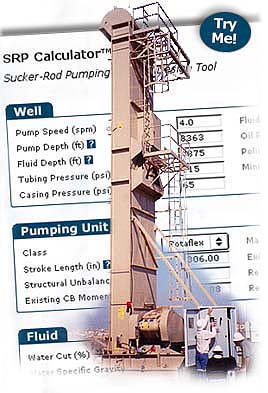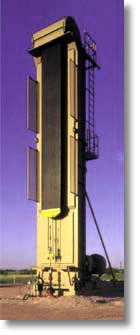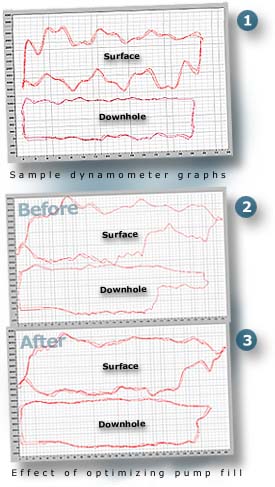Give the SRP Calculator™ a try at www.unicous.com/oilgas/srpcalc.php and let us know what you think. We would appreciate any feedback that can make this tool more useful for you. Check future issues of Solutions or our Web site for enhancements to the SRP Calculator™ as well as other new artificial-lift design tools. You may also want to inquire about our artificial-lift drive systems that incorporate complete dynamic analysis, including dynamometer cards and gearbox torque plots.

PERFORMANCE ANALYSIS TOOL:
SRP Calculator™ Enhanced for Rotaflex Pumps, Phased-Crank Pumps, and Deviated Wells
 Our last issue of Solutions introduced the SRP Calculator™, a convenient design tool for analyzing the performance of sucker-rod pumping systems. That initial version of this free online calculator provided quick and easy analysis of Class I (conventional) and Class III (Mark II) pumping-unit geometries applied to vertical wells.
Our last issue of Solutions introduced the SRP Calculator™, a convenient design tool for analyzing the performance of sucker-rod pumping systems. That initial version of this free online calculator provided quick and easy analysis of Class I (conventional) and Class III (Mark II) pumping-unit geometries applied to vertical wells.
We've made several improvements to the SRP Calculator™ to allow it to be used with a broader range of artificial-lift applications. Pump total vertical depth has been separated from total rod string length to provide a simple method for estimating the performance of deviated wells. The rod configuration has been expanded with separate entries for tapered rod strings and sinker bars. Tapered rods of up to three sections can be conveniently accommodated. Calculations of rod stress at the top of each section have also been added. The SRP Calculator™ has also been expanded to include Rotaflex pumping units as well as phased-crank units like the Torque Master, Reverse Mark, or Maximizer II.
The results from the SRP Calculator™, the Rodstar program from Theta Enterprises, and actual field test results of a Rotaflex pump are summarized in the table below. Most SRP Calculator™ Rotaflex calculations are reasonably close to both Rodstar estimates and the actual field test results. The major difference was in the maximum gearbox torque measured in the field. The actual gearbox torque measured in the field includes the effects of motor speed fluctuations, which are not accounted for in Rodstar or the SRP Calculator™. In that sense, those two programs make conservative estimates of gearbox torque compared to what is likely to occur in actual installations. The SRP Calculator™ results shown in the table below also compare reasonably to the Rodstar and API method (RP 11L) calculations for a Reverse Mark phased-crank pumping unit.
The SRP Calculator™ is not intended to replace the detailed analysis available from commercial rod-pump simulation programs. In many cases, however, detailed analysis is unnecessary and often greatly exceeds the precision of field measurement. Unico's SRP Calculator™ provides simple well analysis of conventional, air-balanced, phased-crank, Mark II, and Rotaflex pumps to help you decide if a more detailed analysis is required.
Rotaflex Analysis Comparison (8,363 ft. well)
| Calculation |
Unico SRP Calculator
|
Theta
Rodstar |
Unico/
Rodstar |
Field
Test |
Unico/
Test |
| Fluid Production Rate (bpd) |
479
|
517
|
-7%
|
493
|
-3%
|
| Oil Production Rate (bpd) |
374
|
403
|
-7%
|
385
|
-3%
|
| Polished Rod Power (hp) |
33.8
|
36.1
|
-6%
|
35.8
|
-5%
|
| Minimum Motor Size (hp) |
50.0
|
50.0
|
0%
|
—
|
—
|
| Required Balance (in-lb) |
360,364
|
359,700
|
0%
|
357,884
|
+1%
|
| Existing Balance Effect (lb) |
21,690
|
21,800
|
-1%
|
21,690
|
0%
|
| Required Balance Effect (lb) |
21,840
|
21,800
|
0%
|
21,690
|
+1%
|
| Max. Gearbox Torque (in-lb) |
158,828
|
169,000
|
-6%
|
140,800
|
+13%
|
| Buoyant Rod Load (lb) |
17,022
|
17,201
|
-1%
|
17,114
|
-1%
|
| Maximum Rod Load (lb) |
31,316
|
31,871
|
-2%
|
31,000
|
+1%
|
| Minimum Rod Load (lb) |
12,365
|
11,739
|
+5%
|
12,300
|
+1%
|
| Upper Section Stress (psi) |
39,550
|
40,452
|
-2%
|
39,148
|
+1%
|
| Middle Section Stress (psi) |
37,302
|
37,835
|
-1%
|
—
|
—
|
| Lower Section Stress (psi) |
31,647
|
30,942
|
+2%
|
—
|
—
|
| Pump Stroke (in) |
267.52
|
288.00
|
-7%
|
277.0
|
-3%
|
Reverse Mark Analysis Comparison (8,000 ft. well)
| Calculation |
Unico SRP Calculator
|
Theta
Rodstar |
Unico/
Rodstar |
API
RP 11L |
Unico/
API |
| Fluid Production Rate (bpd) |
318
|
324
|
-2%
|
331
|
-4%
|
| Oil Production Rate (bpd) |
64
|
65
|
-2%
|
66
|
-4%
|
| Polished Rod Power (hp) |
25.6
|
26.8
|
-4%
|
21.4
|
+20%
|
| Minimum Motor Size (hp) |
50.0
|
50.0
|
0%
|
—
|
—
|
| Required Balance (in-lb) |
1,719,610
|
1,659,720
|
+4%
|
—
|
—
|
| Existing Balance Effect (lb) |
22,844
|
23,367
|
-2%
|
—
|
—
|
| Required Balance Effect (lb) |
21,816
|
21,506
|
+1%
|
21,706
|
+1%
|
| Max. Gearbox Torque (in-lb) |
812,028
|
817,000
|
-1%
|
753,406
|
+8%
|
| Buoyant Rod Load (lb) |
15,906
|
15,909
|
0%
|
15,636
|
+2%
|
| Maximum Rod Load (lb) |
30,578
|
30,550
|
0%
|
28,007
|
+9%
|
| Minimum Rod Load (lb) |
10,456
|
10,043
|
+4%
|
10,389
|
+1%
|
| Upper Section Stress (psi) |
38,689
|
38,770
|
0%
|
—
|
—
|
| Middle Section Stress (psi) |
36,922
|
34,818
|
+6%
|
—
|
—
|
| Lower Section Stress (psi) |
35,103
|
31,334
|
+12%
|
—
|
—
|
| Tubing Stretch (in) |
1.07
|
1.10
|
-3%
|
1.10
|
-3%
|
| Pump Stroke (in) |
124.61
|
130.00
|
-4%
|
128.30
|
-3%
|
PRODUCT WATCH:
Embedded Well Control Taps the Potential of Rotaflex Pumping Units
Unico's Sucker-Rod Pump (SRP) control software has been engineered to tap the potential of Rotaflex artificial-lift systems. Rotaflex pumping units are typically used on deep or gassy wells because of their long, slow strokes. In addition to modeling Rotaflex geometry, the software offers a host of sophisticated features designed to increase efficiency, boost production, and extend equipment life. The software, which is embedded within a Unico drive, provides a racetrack mode, automatic corner anticipation, sensorless surface and downhole dynamometer graphs, pump fill detection and control, gearbox torque protection, and more.
 The innovative racetrack mode and automatic corner anticipation features work hand-in-hand to optimize each stroke. Racetrack mode controls the speed of the upstroke, downstroke, and cornering portions of a cycle independently, allowing the pump to speed up during the straight portions and slow down while cornering to protect the pumping system. While Rotaflex units are typically geared to run at a constant 4.5 spm at 1,150 rpm base speed, Unico's constant-power control extends the motor speed range beyond base speed to 1,750 rpm (6.8 spm) during the upstroke and downstroke straight sections. Since the Rotaflex unit is physically limited to 4.5 spm in the corner, the controller anticipates the corner by automatically slowing the motor to the preset cornering speed at the appropriate time. In this example, racetrack mode increased the average pumping speed to 6.0 spm, resulting in a 33% increase in production. Given typical inflow and motor torque limitations, more modest production increases of 10% to 15% are commonly obtained.
The innovative racetrack mode and automatic corner anticipation features work hand-in-hand to optimize each stroke. Racetrack mode controls the speed of the upstroke, downstroke, and cornering portions of a cycle independently, allowing the pump to speed up during the straight portions and slow down while cornering to protect the pumping system. While Rotaflex units are typically geared to run at a constant 4.5 spm at 1,150 rpm base speed, Unico's constant-power control extends the motor speed range beyond base speed to 1,750 rpm (6.8 spm) during the upstroke and downstroke straight sections. Since the Rotaflex unit is physically limited to 4.5 spm in the corner, the controller anticipates the corner by automatically slowing the motor to the preset cornering speed at the appropriate time. In this example, racetrack mode increased the average pumping speed to 6.0 spm, resulting in a 33% increase in production. Given typical inflow and motor torque limitations, more modest production increases of 10% to 15% are commonly obtained.
 The SRP program also generates surface and downhole dynamometer graphs without requiring external position and load sensors. Using these graphs, the controller can regulate pump fill in real time as well as provide important diagnostics about the pumping system. This is especially useful for wells that are pumping off or suffering from gas interference.
The SRP program also generates surface and downhole dynamometer graphs without requiring external position and load sensors. Using these graphs, the controller can regulate pump fill in real time as well as provide important diagnostics about the pumping system. This is especially useful for wells that are pumping off or suffering from gas interference.
Figure 1 shows the surface and downhole dynamometer plots from a recent Rotaflex start-up. Figures 2 and 3 show the effects of controlling pump fill with Unico's production optimizer. Figure 2 shows the well without the optimizer, while Figure 3 illustrates the benefit of slowing the pumping unit to increase pump fill.
Other SRP software features are engineered to save energy, protect the gearbox from overloading, simplify counterbalance setup, prevent bridle separation, detect belt slip, generate predicted dynamometer graphs, as well as to monitor fluid flow, pump stroke, cumulative production, pumping efficiency, and input power.
WHAT'S COMING UP:
In Future Issues...
Look for the following articles in upcoming issues of Oil & Gas Automation Solutions:
| Taking advantage of utility rate structures to reduce artificial-lift energy costs | |
| Field tests of methods to eliminate rod pump gas locking and interference | |
| Using a torque economizer mode to improve efficiency and reduce gearbox stress | |
| Power loss components in a typical rod pumping system | |
| A novel way of conceptualizing the effectiveness of artificial lifts | |
| Reducing power consumption and improving power factor of beam pumps | |
| Detecting stick/slip oscillations that fatigue rod-string couplings and reduce energy efficiency of PCPs |
Oil & Gas Automation Solutions is a publication of Unico, Inc. Copyright © 2003 Unico, Inc. All rights reserved.
All trade designations are provided without reference to the rights of their respective owners.
![]() Unico, Inc., 3725 Nicholson Rd., P. O. Box 0505, Franksville, WI 53126-0505
Unico, Inc., 3725 Nicholson Rd., P. O. Box 0505, Franksville, WI 53126-0505
262.886.5678 / 262.504.7396 fax
oilgas@unicous.com / unicous.com